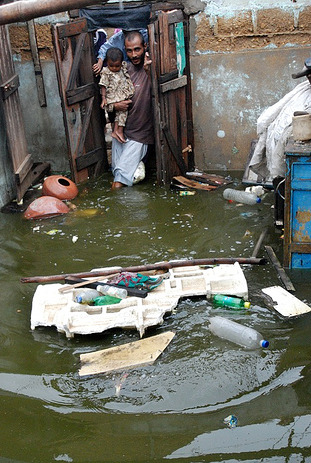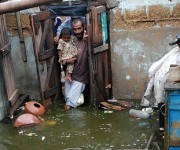 Flooding in Pakistan.Photo: N BCross-posted from World Resources Institute.
Flooding in Pakistan.Photo: N BCross-posted from World Resources Institute.
The world must brace for more extreme weather. That is the clear message from a new report that finds climate change is likely to bring more record-breaking temperatures, heat waves, and heavy downpours. The much-anticipated Special Report on Managing the Risks of Extreme Events and Disasters to Advance Climate Change Adaptation (SREX) — the summary of which was released today by the Intergovernmental Panel on Climate Change (IPCC) — provides new evidence that links extreme weather events and climate change.
According to the summary for policymakers, the SREX report concludes that climate change will likely lead to global increases in extreme weather, along with heightened risks to livelihoods, human health, and infrastructure, both today and in the future. It also describes the costs — in terms of lives lost and economic damages — that have already occurred, plus those that will likely result from this phenomenon, and the societal implications of a warmer world, in which yesterday’s extreme conditions become the new norm.
Below we provide five key takeaways from the report summary:
1. Extreme weather is on the rise around the world.
The report concludes that several types of extreme weather have become more intense or more frequent during the past half-century.1 Specifically, the SREX finds that:
- In the case of temperatures, warm days and nights have become more frequent, and cold days and nights less so.2
- Areas of the world with a significant increase in the number of heavy downpours exceeded the areas of the world where the opposite is true.3
- With “medium confidence,” some areas of the world have experienced more intense and longer droughts.
- The global trend of rising sea levels has led to an increase in the occurrence of extreme coastal high water,4 from tidal or other high water events.
2. Extreme weather and climate disasters are deadly and expensive, and losses are increasing.
Given the recent flooding in Thailand, the drought in the Horn of Africa, and the flooding of the Mississippi and Missouri Rivers, it should come as no surprise to learn that such events are costly — both in terms of lives lost and economic damages. The SREX finds that losses from weather and climate disasters are indeed rising, with the increase largely due to increased exposure, with more people and infrastructure in harm’s way. Developing countries are particularly affected, with the greatest fatality rates (according to the report, during the period from 1970 to 2008, over 95 percent of deaths from natural disasters occurred in developing countries) and economic losses as a proportion of gross domestic product.
3. A warming world will likely be a more extreme world.
The extreme weather events unfolding around the world in recent years are only a harbinger of what is to come. For example, the report finds it is virtually certain5 that the frequency and magnitude of extreme high temperatures will increase, with warm spells, including heat waves, very likely6 increasing in length, frequency, and/or intensity over most land areas. And it is not just temperature extremes that will change. Heavy precipitation events will likely7 increase in frequency, climate projections imply possible changes in floods, and there is medium confidence that droughts will intensify in some seasons and areas.
4. Greenhouse-gas pollution is likely driving some of these trends.
Not only is extreme weather on the rise, but humans are likely driving some of these trends. The report finds it likely that rising greenhouse-gas pollution in the atmosphere has led to the observed rise in extreme high temperatures and to the rise in extreme coastal high water.8 Additionally, report authors attached “medium confidence” to the conclusion that humans have contributed to a global intensification of extreme precipitation. Though remarkable, these findings are not surprising, because they are consistent with what scientists have considered to be likely outcomes in a warmer world.
5. Adaptation and disaster risk management can enhance resilience in a changing climate; differences in vulnerability and exposure must be considered in the design of such initiatives.
Despite its very troubling conclusions, the report also details measures that can be taken to manage risks associated with extreme events. These include risk sharing and transfer mechanisms (e.g., insurance and reinsurance) and “low regret” measures that have co-benefits beyond addressing climate change (e.g., ecosystem restoration, building code enforcement, improved education). While incremental action can help reduce risks, more transformative changes to governance, values, and technological systems will also be required. In designing such interventions, differences in vulnerability and exposure must be considered, as impacts will not play out on a level playing field. A cyclone hitting Australia will not have the same impacts as a cyclone of similar magnitude hitting Bangladesh.
Tomorrow’s world will be a different one. Governments around the world must get serious about reducing greenhouse-gas emissions — both quickly and steeply — if we are to have a fighting chance for maintaining a more stable climate. The upcoming U.N. climate negotiations in Durban, South Africa, provide a critical opportunity for leadership on increasing the ambition of mitigation and finance commitments. Changes in extremes also place a premium on disaster risk management and adaptation initiatives that increase the resilience of those affected. Governments around the world are already acting to move from disaster relief to disaster preparedness, providing innovative examples that can be scaled up.
We have introduced five specific takeaways, but the most important message is this: We can no longer ignore the link between climate change and extreme weather events.
The time for decisive action to reduce emissions, advance adaptation, and move toward a better future climate is now.
Footnotes:
1. It should be noted that available weather and climate data are almost always more limited than research scientists would want them to be, both in terms of their coverage over time and spatial areas across the globe. This is particularly true for studies that focus on extreme weather events, which are very rare occurrences, by definition. This helps to explain why the science has heretofore been somewhat inconclusive on the issues of extreme weather addressed in the SREX, making the findings of this report all the more remarkable.
2. The report determines that available evidence supports this conclusion at the 90 to 100 percent probability level.
3. The report determines that available evidence supports this conclusion at the 66 to 100 percent probability level.
4. The report determines that available evidence supports this conclusion at the 66 to 100 percent probability level.
5. 99 to 100 percent probability assigned to the likelihood of the outcome.
6. 90 to 100 percent probability assigned to the likelihood of the outcome.
7. 66 to 100 percent probability assigned to the likelihood of the outcome.
8. The report determines that available evidence supports this conclusion at the 66 to 100 percent probability level.


